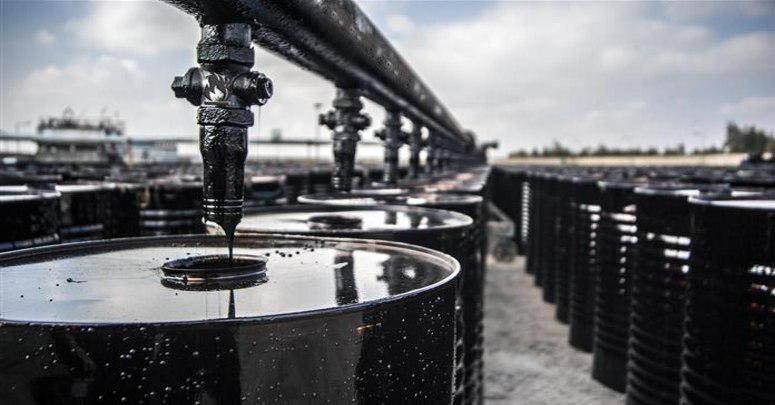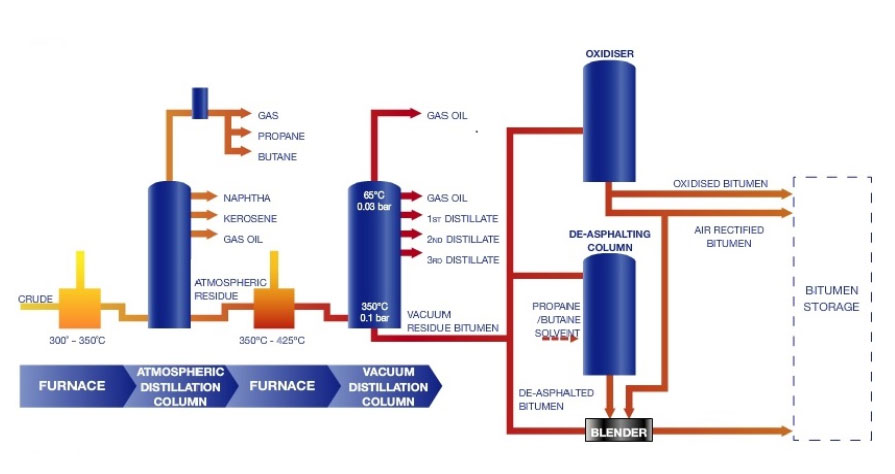
What is bitumen?
Bitumen is a mixture of dense, sticky, viscous organic liquids, which is mainly composed of polycyclic aromatic hydrocarbons, obtained naturally from crude oil distillation.
Naturally occurring or crude bitumen is a sticky, tar-like form of petroleum which is so thick and heavy that it must be heated or diluted before it can flow.
At room temperature, it is much like cold ooze. Refined Bitumen is the residual (bottom) fraction obtained by fractional distillation of crude oil. It is the heaviest fraction and the one with the highest boiling point of 525 °C (977 °F).
Naturally occurring or crude bitumen is a sticky, tar-like form of petroleum which is so thick and heavy that it must be heated or diluted before it can flow.
At room temperature, it is much like cold ooze. Refined Bitumen is the residual (bottom) fraction obtained by fractional distillation of crude oil. It is the heaviest fraction and the one with the highest boiling point of 525 °C (977 °F).
PENETRATION GRADE | CUT BACK – MC GRADE | EMULSION | OXIDIZED | VISCOSITY GRADE
Properties of Bitumen
- Adhesion: Bitumen is capable of adhering to a solid surface in a fluid state depending on the type of the surface. The presence of water on the surface prevents adhesion.
- Resistance to Water: Bitumen is known as a water proof substance. Under some conditions water may be absorbed by adding slight amount of inorganic salts in the bitumen or filler therein.
- Hardness: To measure the hardness of bitumen, the penetration test is carried out, which measures the depth of penetration a weighted needle in tenths of mm. of bitumen after a given time, at a certain temperature (generally a weight of 100 gm is applied for 5 sec at a temperature of 77 °F). The penetration is a measure of hardness. Typical results are 10 for hard coating asphalt, 15 to 40 for roofing asphalt and up to 100 or more for water proofing bitumen.
- Viscosity and Flow: The viscous or flow properties of bitumen are of importance both at high temperature during processing and application and at low temperature to which bitumen is subjected during service. The flow properties of bitumen vary considerably by temperature and stress conditions. Deterioration, or loss of the desirable properties of bitumen, takes the form of hardening which, consequently, decrease the adhesive and flow percentage and an increase in the softening point temperature and coefficient of thermal expansion.
- Softening point: Softening point is the temperature at which a steel ball be thrown at a known distance through the bitumen when the test subject is heated at a known rate. Usually the test consist of a 3.8-cm-diameter steel ball, weighted 3.5 gm, which is allowed to sink through a 5.8 cm in diameter, 1.4 cm in thick disk of bitumen in a brass ring. The whole subject is heated at a rate of 9 °F per min. Typical values would be 240 °F for coating grade asphalts, 140 °F to 220 °F for roofing asphalt and down to 115 °F for bituminous water proofing material.
- Ductility: Ductility test is conducted to determine the amount at which bitumen will stretch at temperature below its softening point. A briquette having a cross sectional area of 1 in 2 is placed in a tester at 77 °F. Ductility values ranges from 0 to over 150 depending on the type of bitumen.
Difference between Bitumen and Tar
Bitumen and tar are both viscous dark organic liquids which seep out of the ground. They are also both used as waterproofing and sealing agents in the construction of boats and buildings. They also both have medicinal uses.
Although there are many similarities, there are some differences between bitumen and tar. They include the following.
Although there are many similarities, there are some differences between bitumen and tar. They include the following.
Composition
Bitumen is primarily composed of aromatic hydrocarbons associated with oil deposits. Tar, on the other hand, can form in association with oil or it can be formed from wood.
Characteristics
Bitumen can occur in solid form or as a dark viscous liquid whereas tar is chemically distinct and occurs primarily as a viscous liquid.
Production
Bitumen occurs naturally and can be prospected from the ground whereas tar is usually produced through distillation.
| Characteristics | Bitumen | Tar |
| Source | Derived only from sources associated with coal and oil | Can be derived from petroleum or coal and wood |
| Occurrence | Occurs in solid form and as a viscous liquid | Usually occurs only as a viscous liquid |
| Nature | Can be naturally occurring | Usually needs to be distilled |

- Distillation
Atmospheric and vacuum distillation is known as the most common refining process of bitumen from crude or a crude blend. As observed in the above figure, lighter petrochemical and fuel fractions are detached from the non-boiling component (atmospheric residue) at the bottom of the column through the distillation process. The lighter fractions; comprising, gas oil and fuel oils are foddered to other refinery units. The atmospheric residue is reserved in the specific tankers for bitumen. Toward removing all traces of the lighter fractions and avoiding heat transmission between molecules, the atmospheric residue is led into a vacuum distillation unit, where the pressure reduction lowers boiling temperatures and unwanted thermal cracking.
- Oxidation (Air Blowing)
When blowing air through bitumen at higher temperatures (280°C on average) during its further production process the result will be a product with some altered physical properties that used for certain commercial applications.
Depending on the degree of oxidation, oxidized bitumen categorized into two diverse types: air rectified and oxidized. Oxidized bitumen has a unique stability at room temperature and a rubbery feature which affects how it responds to stress, or imprint. The process of oxidation increases the stiffness and softening point of the bitumen and significantly modifies vital physical properties. Variation in the time during which the oxidation occurs or the amount of air being blown, varies the extent of the reaction and produces distinctive end products. Oxidized bitumen is used in roofing applications, while air rectified bitumen is used in paving applications and some roofing applications.
- Blending
The final bitumen product can be produced to technical specification either directly in the refining process or by blending bitumen with different substances with various physical properties. Blending of higher and lower viscosity residues in the required proportions may take place at the refinery, at terminals or at a third party facility, where blend components and finished products can be easily transported and distributed for use.
Atmospheric and vacuum distillation is known as the most common refining process of bitumen from crude or a crude blend. As observed in the above figure, lighter petrochemical and fuel fractions are detached from the non-boiling component (atmospheric residue) at the bottom of the column through the distillation process. The lighter fractions; comprising, gas oil and fuel oils are foddered to other refinery units. The atmospheric residue is reserved in the specific tankers for bitumen. Toward removing all traces of the lighter fractions and avoiding heat transmission between molecules, the atmospheric residue is led into a vacuum distillation unit, where the pressure reduction lowers boiling temperatures and unwanted thermal cracking.
When blowing air through bitumen at higher temperatures (280°C on average) during its further production process the result will be a product with some altered physical properties that used for certain commercial applications.
Depending on the degree of oxidation, oxidized bitumen categorized into two diverse types: air rectified and oxidized. Oxidized bitumen has a unique stability at room temperature and a rubbery feature which affects how it responds to stress, or imprint. The process of oxidation increases the stiffness and softening point of the bitumen and significantly modifies vital physical properties. Variation in the time during which the oxidation occurs or the amount of air being blown, varies the extent of the reaction and produces distinctive end products. Oxidized bitumen is used in roofing applications, while air rectified bitumen is used in paving applications and some roofing applications.
The final bitumen product can be produced to technical specification either directly in the refining process or by blending bitumen with different substances with various physical properties. Blending of higher and lower viscosity residues in the required proportions may take place at the refinery, at terminals or at a third party facility, where blend components and finished products can be easily transported and distributed for use.

